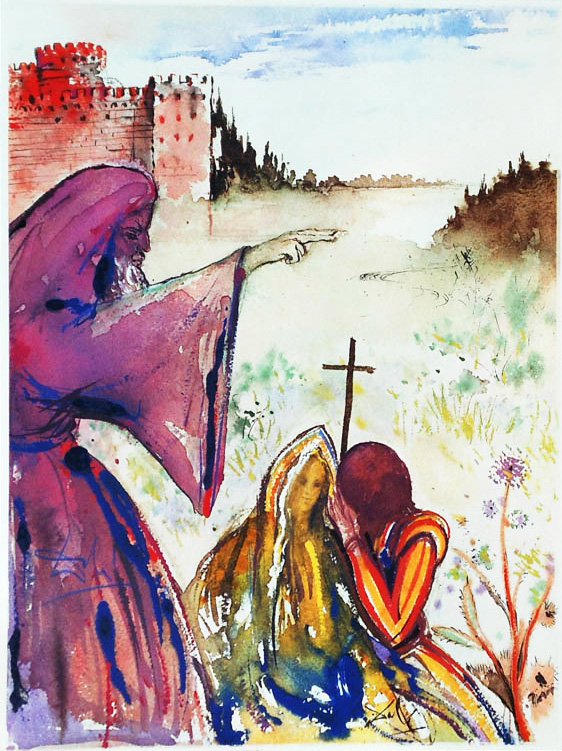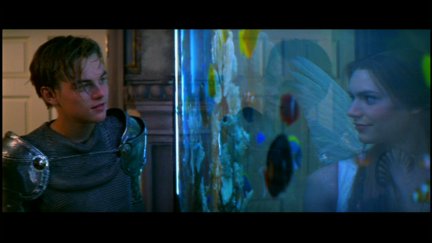 |
| Illustrations for Romeo and Juliet, by Salvador Dali |
 |
So many people first encounter the play in high school, as an introduction to Shakespeare. I was not one of them, and I am grateful for this; it saved me from inevitable moralizing approaches to the play, with heavy emphases on why you should always listen to your parents, that teenage relationships aren't stable and will never last. Salient as such observations undeniably are to social situations in the so-called real world, they relate little to a substantive consideration of Shakespeare's text. Ironically, such an attitude to the story aligns more closely to Arthur Brooke's The Tragicall Historye of Romeus and Juliet,(1562), the long narrative poem considered to be the chief source for Shakespeare's play(though Shakespeare was also indebted to Ovid's Metamorphoses, particularly the story of Pyramus and Thisbe, later parodied to great effect in A Midsummer Night's Dream). The introductory "To the Reader" sounds a note of unambiguous finger-wagging:
And to this end, good Reader, is this tragical matter
written, to describe unto thee a couple of unfortunate lovers, thralling
themselves to unhonest desire; neglecting the authority and advice of
parents and friends; conferring their principal counsels with drunken
gossips and superstitious friars (the naturally fit instruments of
unchastity); attempting all adventures of peril for th' attaining of their
wished lust; using auricular confession the key of whoredom and
treason, for furtherance of their purpose; abusing the honourable
name of lawful marriage to cloak the shame of stolen contracts;
finally by all means of unhonest life hasting to most unhappy death.
While Shakespeare took the general shape of the plot and character names from Brooke, the tone is conspicuously different. The sonnet that opens the play, while positioning the young lovers as "star-crossed"(6) and "death-marked"(9), doesn't condemn them or their passion. If their love was doomed, it wasn't rightfully so; rather, it was the result of a wrong-turning world. Romeo's description of Juliet at the masked ball as having "Beauty too rich for use, for earth too dear"(1.5.46) could just as well have been applied to their love and its inevitable fate in the world of the play.
Indeed, in the world of the play, love is positioned as a different way of seeing the world, of seeing reality. This is conveyed through the use of language. At the beginning, when Romeo is infatuated with a girl named Rosaline, he's constantly spouting overdone oxymoronic turns of phrase: "Why then, O brawling love, O loving hate,/O anything of nothing first create/O heavy lightness, serious vanity,/Misshapen chaos of well-seeming forms"(1.1.173-177) At the time Shakespeare was writing, this would've been recognized as stock flowery expression in the Petrarchan vein; even today, just about any Valentine's day card cliche you can think of is traceable to Petrarch. When he sees Juliet, however, he switches to blank verse, the conceits becoming more potent and emotionally charged. When he and Juliet first speak to one another, their exchanging lines form a sonnet. This isn't simply Shakespeare being a clever show-off; the elevation of the language marks the elevation of his young hero's sensibility. Romeo goes from being in love with the idea of being in love, to being in love with another human being.
Intriguingly, Juliet emerges as the stronger partner in their dynamic. Any production that portrays her as a ditzy bimbo sets itself up for gross inadequacy. As Rene Weis observes in the introduction to the Arden third series edition of the play, "Compared to Juliet, Romeo is almost a cipher, at least as far as family and past life are concerned...The play may have started as 'Romeo and Juliet', but it ends as 'Juliet and Romeo', a hierarchy more truly reflective of the essence of the drama."(7) Despite her extreme youth and extremely gender-specific seclusion, Shakespeare positions her as the true guiding spirit in their love affair. She not only handles the practical details of their marriage, she also encourages his rejection of trope in favor of something real to ground his love in.
 |
| Baz Lurhmann's Romeo + Juliet(1996) |
Indeed, in the world of the play, love is positioned as a different way of seeing the world, of seeing reality. This is conveyed through the use of language. At the beginning, when Romeo is infatuated with a girl named Rosaline, he's constantly spouting overdone oxymoronic turns of phrase: "Why then, O brawling love, O loving hate,/O anything of nothing first create/O heavy lightness, serious vanity,/Misshapen chaos of well-seeming forms"(1.1.173-177) At the time Shakespeare was writing, this would've been recognized as stock flowery expression in the Petrarchan vein; even today, just about any Valentine's day card cliche you can think of is traceable to Petrarch. When he sees Juliet, however, he switches to blank verse, the conceits becoming more potent and emotionally charged. When he and Juliet first speak to one another, their exchanging lines form a sonnet. This isn't simply Shakespeare being a clever show-off; the elevation of the language marks the elevation of his young hero's sensibility. Romeo goes from being in love with the idea of being in love, to being in love with another human being.
 |
| Franco Zeffirelli's Romeo and Juliet(1968) |
Romeo: Lady, by yonder blessed moon I vow,
That tips with silver all these fruit-tree tops-
Juliet: O swear not by the moon, th'inconstant moon,
That monthly changes in her circled orb,
Lest that they love prove likewise variable.
Romeo: What shall I swear by?
Juliet: Do not swear at all,
Or if thou wilt, swear by thy gracious self,
Which is the god of my idolatry,
And I'll believe thee. (2.2.107-114)
She is wiser than he, as well as more practical. She is also the partner depicted in the most explicit physical longing. Her speech at the beginning of act 3, scene 2, urging on the coming of the night that bring her husband to her bed is a case in point. "Spread thy close curtain, love-performing night,/That runaways' eyes may wind, and Romeo/Leap into these arms, untalked of and unseen."(3.2.5-7) The most frequent hallmarks of the idealized lady of a Petrarchan style was that she was cold and distant, unattainable to the male lover desperately hoping trying to reach her. Shakespeare's Juliet is clearly neither of these things. It is a measure of just how unique Shakespeare's telling of the story is, that he grants his young girl in love a bright intellect and an erotic longing that not only aren't in conflict, but complement one another.
 |
| Romeo and Juliet, by Frank Dicksee |
Though it concludes in death, Romeo and Juliet has much the same aura of a fairy tale or an old myth(it was written, oddly enough, around the same time that Shakespeare also produced A Midsummer Night's Dream). The power it can have over an engaged reader or over an audience(if the performance is well-directed and well-cast)is in significant ways psychological instead of logical. It is what Isak Dinesen would call an "immortal story", occupying the same space that Tristan and Isolde and Layla and Majnun do. Liebestod stories endure not because they are manuals for how to conduct relationships, but because they offer a uniquely secular vision of the Sublime: simultaneously beautiful and terrifying and exalting. As such, moralizing generalizations and gestures toward sappy domestication are set aside in the end. Death is in an infinite and undeniable reality(in Shakespeare's Verona, and in the living world we inhabit), but so is Juliet's bounty. "My bounty is as boundless as the sea,/My love as deep; the more I give to thee the more I have, for both are infinite."(2.2.133-135)
Liebestod, from Wagner's Tristan und Isolde
Works Cited
Brooke, Arthur. The Tragicall Historye of Romeus and Juliet. 1562. Canadian Adaptations of Shakespeare Project. Pdf.
Shakespeare, William. Romeo and Juliet. Arden Third Series. edited by Rene Weis. 2012. Print.
No comments:
Post a Comment